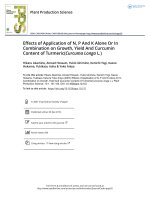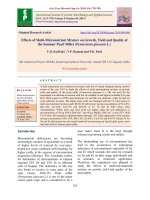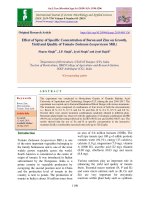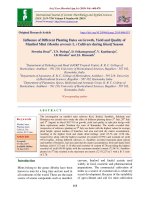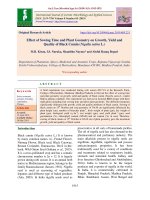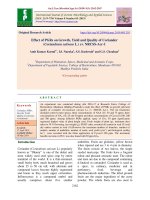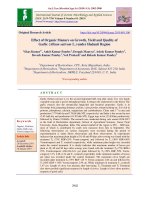Integrated nutrient management studies on growth, yield and quality attributes in chilli (Capsicum annuum L.)
Bạn đang xem bản rút gọn của tài liệu. Xem và tải ngay bản đầy đủ của tài liệu tại đây (246.6 KB, 9 trang )
Int.J.Curr.Microbiol.App.Sci (2019) 8(2): 2518-2526
International Journal of Current Microbiology and Applied Sciences
ISSN: 2319-7706 Volume 8 Number 02 (2019)
Journal homepage:
Original Research Article
/>
Integrated Nutrient Management Studies on Growth, Yield and Quality
Attributes in Chilli (Capsicum annuum L.)
M. Yogaraju*, V. Srinivasa, Y.M. Mahadevprasad and Devaraju
Department of Vegetable Science, College of Horticulture, Mudigere, University of
Agricultural and Horticultural Sciences, Shivamogga, Karnataka, India
*Corresponding author
ABSTRACT
Keywords
Chilli, INM ,
Biofertilizers,
Micronutrient
mixture
Article Info
Accepted:
18 January 2019
Available Online:
10 February 2019
A field experiment was conducted on “Effect of INM practices on plant growth, fruit yield
and quality attributes in chilli at College of Horticulture, Mudigere during rabi season.
Results revealed that, among the different treatments, the combination of Azospirillum +
PSB + VAM + KSB + 50% RDF + MgSO 4 + Micronutrient mixture stimulated better
response in terms of growth yield and quality attributes of chilli (T 12). The maximum plant
height (88.61 cm), number of primary and secondary braches per plant (11.22 and 18.44,
respectively), number of leaves (298.87), leaf area of plant (10578.06 cm 2), leaf area index
(3.92) and total dry matter (118.48 g/plant) were recorded in treatment T 12. The same
treatment also recorded maximum fruit length (11.60 cm), fruit girth (4.80 cm), fresh
weigh of fruit/plant (268.89 g), fruit yield /plant (658.67 g), yield/ plot (13.75 kg) and
yield/ha (22.92 t/ha). Quality parameters like chloropyll content in leaves (79.74 SPAD
units), ascorbic acid content (141.27 mg/100g) and capsaicin content (0.39 %), were also
recorded maximum in the same treatment. Thus, combined use of organic and inorganic
manures, biofertilizers and micronutrient mixture proved better in improving the growth,
yield and quality attributes than using inorganic nutrients alone.
Introduction
Chilli (Capsicum annuum L.) is one of the
most important spices cum vegetable crops of
the world, it is widely cultivated in the warm,
humid, tropical and subtropical countries.
Being an important commercial crop, it finds
diverse utilities as spice, condiment, culinary
supplement and medicinal value. Chillies are
nature‟s wonder, its fruits appear in various
size, shape and colour. Chillies have two
important qualities, such as red colour due to
capsanthin pigment and biting pungency by
capsaicin. India is the largest producer,
consumer and exporter of chilli, which contribute to 25% of total world‟s production.
Andhra Pradesh is the largest producer of
chilli in India, contributes about 30% to the
total area under chilli, followed by Karnataka
(20%), Maharashtra (15%), Orissa (9%),
Tamil Nadu (8%) and other states
contributing 18% to the total area under chilli
reported (Kumar, 2013).
During cultivation of chilli indiscriminate and
2518
Int.J.Curr.Microbiol.App.Sci (2019) 8(2): 2518-2526
continuous application of chemical fertilizers
resulted in ecological imbalance with
consequent ill effects on soil as well as
environment and increases the cost of
cultivation. Chilli production has to be
increased primarily from enhancing the
productivity with a combination of high
yielding plant types, standard agronomic
practices like seed priming and balanced plant
nutrition attained through integrated nutrient
management
(INM).
Since
chemical
fertilizers alone will not be able to sustain the
productivity, among which balanced nutrition
is one of the most important factor that
affecting the growth and productivity of chilli.
Hence off late, lot of importance is given to
integrated nutrient management. Therefore
this study has been conducted to ensure the
nutrient requirement of the crop by
integration of organic, inorganic and
biofertilizers which helps not only to increase
the yield but also maintains the soil health and
ecofriendly environment. In this context, the
INM practice is quite encouraging.
Materials and Methods
The present investigation was carried out at
College of Horticulture Mudigere during
October 2016 to March 2017 to test the
potentiality of biofertilizers on chilli namely
Azospirillum, PSB, VAM, KSB, along with
MgSO4 and micronutrient mixture. The
experiment was laid out in randomized
complete block design (RCBD) with three
replications. The seeds of Arka Supal were
sown in the nursery. 40 days seedlings were
transplanted in ridge and furrow method at
spacing of 60 x 45cm. At the time of
transplanting seedling were dipped in
bioinoculants according to treatments and
after 10 DAT, 100 g of solid biofertilizers are
mixed with 1 kg of FYM and applied to
individual plot. Whereas MgSO4 applied as
soil application @ 12.5 kg /acre after the one
week of transplanting. Well decomposed
FYM @ 25 tonnes per hectare was applied at
the time of land preparation. The
recommended dose of 150:75:75 kg NPK/ha
was applied in the form of urea, single super
phosphate and muriate of potash, respectively.
The micronutrient mixture (vegetable specialIIHR) which contains all the secondary
nutrients like boron, zinc, calcium, sulphur
and copper was applied as foliar application at
15 days interval gap during 35, 50 and 65
days of the cop growth stage with dosage of
6.5 g/liter of water. The data on various
biometrical parameters recorded during the
period of investigation was tabulated and
subjected to statistical analysis. The test of
significance („f‟ test) and critical difference
(CD) were read at 0.05 probability.
The treatment details as follows
T1- RDF (Control)
T8- KSB + 100% RDF
T2- Azosipirillum +100 % RDF
+75 % K+RD of NP
T9- KSB
T3- Azospirillum +75%N+RD of PK
T10Azospirillum + PSB + VAM + KSB +
75%RDF
T4- PSB + 100%RDF
T11- Azospirillum +
PSB + VAM + KSB + 50% RDF
T5- PSB +75%P+RD of NK T12- T10
MgSO4 + Micronutrient mixture
T6- VAM+100%RDF
Micronutrient mixture
+
T13- T11 + MgSO4 +
T7- VAM+75%P+RD of NK T14- RDF +
MgSO4 + Micronutrient mixture
Plant height (cm)
Plant height was recorded at intervals of 30,
60, 90 DAT and at harvest by measuring the
length from the base of the plant (ground
level) to the growing tip of the main stem
from all the tagged plants and average was
2519
Int.J.Curr.Microbiol.App.Sci (2019) 8(2): 2518-2526
worked out and expressed in centimeters.
Number of branches
Numbers of primary as well as secondary
branches produced per plant were recorded
from tagged plants by counting the number of
branches at monthly intervals from 30 DAT to
harvest and average was worked out and
expressed in numbers.
Number of leaves per plant
The total numbers of leaves produced in each
tagged plant at 30, 60, 90 DAT and at harvest
were counted and average was worked out
and expressed in numbers.
Leaf area per plant (cm2)
Leaf area was recorded by taking 25 leaves
evenly from bottom, middle and top portion
of the plant using leaf area meter (LICOR
portable leaf area meter) at 30, 60, 90 and at
harvest then average was worked out and
expressed in cm2
Leaf area index
The leaf area index at various stages was
calculated by using formula suggested by
(Seestak et al., 1971).
Where, A = Leaf area in cm² (The leaf area
was estimated with the help of a leaf area
meter).
P = Ground area covered by plant in cm²
LAI=A/P
Total dry matter (g)
The data pertaining to total dry matter
production (TDM) recorded at 60 and 90
DAT
Fruit length (cm)
Five fruits were used for determining the fruit
length. Length from base to the tip of the fruit
measured using metric scale, averaged and
expressed in centimeters as length of the fruit.
Fruit girth (cm)
Five fruits selected for determining the fruit
weight and fruit length were used for
determining the fruit girth. The girth of the
individual fruit was measured at the centre of
the fruit with the help of thread and scale
average fruit expressed in centimeters as girth
of the fruit.
Fresh weight fruit per plant (g)
Tagged plants from each treatment were
selected and harvest the mature green fruits.
The average of harvested tagged plant fruits
weight was recorded as fresh weight of fruits
per plant and expressed in grams.
Fruit yield per plant (g)
The weight of fruits per plant harvested from
randomly tagged five plants from each
treatment and each replication was noted
down at each picking. The total weight of
fruits harvested in each picking was
computed, averaged and expressed in weight
per plant in grams
Fruit yield per plot (Kg)
The weight of fruits harvested from each
picking was recorded from each plot
(including the tagged plants) and total yield
per plot was estimated by adding the yield of
all the harvest expressed in kilograms per
plot.
Yield per hectare (t)
Fruits harvested in each plot from all pickings
were measured in kilograms. Yield per
hectare was calculated by using following
2520
Int.J.Curr.Microbiol.App.Sci (2019) 8(2): 2518-2526
formula and expressed in tonnes per hectare.
Capsaicin content in fruit (%)
Samples of the mature green fruits were
analyzed for their ascorbic acid content using
2,
6-dichlorophenol
visual
method
(Thimmaiah, 1999). The green fruits were cut
into two to three mm pieces and two gram
sample was blended with 0.4 per cent oxalic
acid and filtered through muslin cloth. To an
aliquot of the extract (2 ml) of the sample, 3
ml acid mixture was added and titrated
against the standard dye; the end point is the
appearance of pink colour (V2). Similar
procedure was followed against acid mixture
to get blank titre value and against standard
solution made in 0.4 per cent oxalic acid to
get standard titre value (V1).
Dry chillies were ground and powdered
through sieve No.40. This chilli powder was
used to determine the capsaicin content using
spectrophotometer method developed by
(Palacio, 1979)
Results and Discussion
Chlorophyll content in leaf (SPAD units)
Chlorophyll content of leaf was analyzed by
spad meter. Collect the healthy, fully opened
and matured leaves and insert the spad meter
to the middle and bottom portion of the leaf at
peak growth stage and recorded the value of
randomly selected five plant and it expressed
in spad units.
Procedure
Two grams of chilli powder was placed in
100 ml of volumetric flask and diluted to
make up the volume with “ethyl acetate”. It
was allowed to stand for 24 hours to extract
the capsaicin.
One milliliter of the extract was diluted to
five milliliters with ethyl acetate. Just before
reading 0.5 ml of 0.5 per cent vanadium
oxychloride (VOCl3) solution in ethyl acetate
was added and shaken. The optical density of
the solution was read at 720 nm in spectronic20. Standard curve was prepared by using 0.5,
1.0, 1.5, 2.0 and 2.5 ml of standard capsaicin
solution containing 50, 100, 150, 200 and 250
μg capsaicin respectively.
Ascorbic acid content (mg/ 100g)
The growth parameters of chilli were
significantly influenced by different nutrient
management practices and biofertilizers
amendments at all the growth parameters are
presented in the Table 1.
Significantly higher plant height (88.61cm)
was recorded in the plants which supplied
with Azospirillum + PSB + VAM + KSB +
75% RDF + MgSO4 + Micronutrient mixture
(T12) and it was on par with T6 (78.62 cm),
T10 (84.08 cm), T11 (81.27 cm) and T13
(84.53). Whereas lower plant height was
recorded in (RDF) T1 (65.33 cm). The results
of present investigation are in close
conformity with the findings of (Deshpande et
al., 2010). The results suggest that, the
combined application of inorganic fertilizers
biofertilizers and micronutrient mixture was
superior with respect to plant height
compared to individual application (Malik et
al., 2011).
The application of Azospirillum + PSB +
2521
Int.J.Curr.Microbiol.App.Sci (2019) 8(2): 2518-2526
VAM + KSB + 75% RDF + MgSO4 +
Micronutrient mixture (T12) resulted in
significantly higher number of primary as
well as secondary branches per plant (11.22
and 18.44, respectively) compared to RDF
(6.78 and 11.33, respectively). The production
of more number of primary as well as
secondary branches per plant could be due to
higher metabolic activity because of optimum
nitrogen supplied by Azospirillum and VAM
fertilizers resulting in higher production of
carbohydrates and phytohormones like NAA
and cytokinins might have resulted in
breaking of apical dominance and accelerated
higher number of branches. The findings are
in line with the results of Medhe et al.,
(2010), Deshpande et al., (2010), Hiraguli
and Allolli (2005).
With respect to leaves as food manufacturing
factory of plant and leaf area a site of
photosynthesis is responsible for variation in
the yield. Significant results were found
among the different treatments, maximum
number of leaves (298.87), leaf area
(10578.06 cm2), leaf area index (3.92) and
total dry matter (118.48 g/plant) were
recorded in Azospirillum + PSB + VAM +
KSB + 75% RDF + MgSO4 + Micronutrient
mixture (T12) compared to RDF (T1).
The maximum number of leaves in this
treatment could also be attributed to the
increased availability of nitrogen, which is an
important constituent of chlorophyll and
proteins leads to more growth. Further, it
might also be due to the presence of growth
promoting
substances
produced
by
biofertilizers which would have accelerated
the differentiation of leaf primordial in the
apical growing region led to increased
production of leaves. The results obtained are
in confirmation with the findings of Hiraguli
and Allolli (2005) in chilli who reported that,
combined application of Azospirillum + PSB
+ FYM+ 25% RDF significantly increased the
number of leaves and LAI. Similar findings
were reported by Deore et al., (2010). The
increase in total dry matter may be due to
increase in number of leaves, plant size and
fresh biomass which in turn yields higher dry
matter content. This result is in conformity
with the findings of Hiraguli and Allolli
(2011).
The treatment which received Azospirillum +
PSB + VAM + KSB + 75 % RDF + MgSO4 +
Micronutrient mixture (T12) produced
significantly the maximum fruit length (11.60
cm), fruit girth (4.80 cm), fresh weight of fruit
per plant (268.89 g), fruit yield per plant
(658.67 g), fruit yield per plot (13.75 kg) and
fruit yield per ha (22.92 t/ha) followed by T13,
T10 and T11, respectively compared to RDF
(T1) (Table 2). This might be due to better
physiological condition of plant and increased
population of microflora, thereby enhanced
availability
of
nutrients
through
mineralization process. Higher yield could be
due to the regular supply of nutrients leads to
more vegetative growth leading to increase in
photosynthetic area, which inturn resulted in
more synthesis and accumulation of dry
matter in the fruit. Moreover, presence of
growth promoting substances such as auxin,
gibberllins and cytokinin due to presence of
biofertilizers would have also contributed in
development and accumulation of sink
resulting in better growth and subsequently
more number of fruits per plant and maximum
fruit yield per hectare. These results are
agreement with the results of Kondapanaidu
et al., (2009), Hiraguli and Allolli (2011) and
Leelarani et al., (2015).
It is evident from the result that application of
organic, inorganic nutrients and biofertilizer
amandement
significantly
increased
chlorophyll content at peak vegetative stage
(Table 3).
2522
Int.J.Curr.Microbiol.App.Sci (2019) 8(2): 2518-2526
Table.1 Effect of INM on growth characters of chilli
Treatments
plant height
(cm)
Number
of
primary
Branches
/plant
Number of
secondary
branches
/plant
Number of
leaves/plant
Leaf area
(cm2)
Leaf
Area
Index
(LAI)
Total Dry
matter/plant
(g)
T1
T2
T3
T4
T5
T6
T7
T8
T9
T10
T11
T12
T13
T14
S.Em±
CD@5%
65.33
74.83
70.57
76.53
72.1
78.62
72.13
71.63
69.6
84.08
81.27
88.61
84.53
75
3.84
11.18
6.78
7.78
7.44
7.56
7.33
9.00
8.33
7.78
7.11
9.44
8.33
11.22
9.67
7.89
0.53
1.53
11.33
15.11
14.44
14.67
14.11
15.89
15.22
14.56
14.11
16.44
16.11
18.44
16.78
15.56
0.91
2.64
226.67
250
243
233.67
227.8
240.77
236.83
236
225.83
279.8
271.8
298.87
281.77
219.33
14.39
41.84
6431.9
8058.1
7183.75
6797.23
6473.89
7477.63
6953.08
7102.36
6470.7
9581.23
8613.61
10578.1
9183.06
6697.3
471.34
1370.17
2.27
2.98
2.63
2.52
2.34
2.77
2.58
2.63
2.52
3.55
3.19
3.92
3.4
3.48
0.14
0.4
87.32
95.36
91.81
97.07
92.71
100.55
97.48
99.28
93.96
108.95
103.23
118.48
112.74
99.77
4.18
12.16
Table.2 Effect of INM on yield characters of green chilli
Treatments
Fruit
length (cm)
Fruit
girth
(cm)
T1
T2
T3
T4
T5
T6
T7
T8
T9
T10
T11
T12
T13
T14
S.Em±
C D@5%
7.53
9.29
8.74
8.72
8.59
8.48
8.17
9.77
9.12
10.83
10.54
11.6
11.25
10.3
0.57
1.66
3.6
3.92
3.63
4.38
3.94
3.93
3.48
4.61
4.08
4.69
4.5
4.8
4.72
4.63
0.25
0.72
Fresh
weight of
fruit/plan
t (g)
188.67
202.78
188.89
208.88
197.22
219.44
208.89
231.11
215
240.56
218.89
268.89
244.44
218.33
13
37.78
2523
Fruit
yield
/plant (g)
Yield/
plot (kg)
Yield/ha
(t)
430.67
494
458.33
499.33
457.33
520
488.33
576.67
515
600.1
574.4
658.67
628.33
555
32.16
93.5
9.16
10.4
9.72
10.64
9.3
11.36
10.44
12.07
11.7
12.66
12.2
13.75
13.28
12
0.74
2.15
15.27
17.33
16.2
17.73
15.5
18.93
17.4
20.12
19.5
21.1
20.33
22.92
22.13
20
1.23
3.58
Int.J.Curr.Microbiol.App.Sci (2019) 8(2): 2518-2526
Table.3 Effect of INM on quality characters of chilli
Treatments
T1
T2
T3
T4
T5
T6
T7
T8
T9
T10
T11
T12
T13
T14
S.Em±
C D@5%
Chloropyll
content in leaves
(SPAD units)
56.33
63.86
62.89
61.37
59.77
69.79
66.77
63.13
60.29
72.4
71.7
79.74
75.81
73.77
4.04
11.73
The maximum chlorophyll content (SPAD
units) was (79.74) was recorded in
Azospirillum + PSB + VAM + KSB + 75%
RDF + MgSO4 + Micronutrient mixture (T12)
Ascorbic acid
content
(mg/100g)
110.67
124
116.67
123.33
111.33
127.17
121.33
130
126.67
135.63
129.93
141.27
138.47
118.33
5.26
15.3
Capsaicin
content (%)
0.22
0.3
0.25
0.32
0.26
0.34
0.31
0.34
0.31
0.36
0.33
0.39
0.37
0.3
0.02
0.06
over RDF (56.33). This might be due to
enhanced availability of nutrients, constituent
of protein and protoplasm resulting in greater
photosynthetic activity. These results are in
2524
Int.J.Curr.Microbiol.App.Sci (2019) 8(2): 2518-2526
line with the earlier findings of Alaboz et al.,
(2017).
The ascorbic acid and capsaicin content of
chilli differed significantly by adopting
different nutrient management practices and
application of biofertilizers amendments.
Significantly, the highest values were
observed in chilli with regard to above
characters when it was supplemented with
Azospirillum + PSB + VAM + KSB + 75%
RDF + MgSO4 + Micronutrient mixture (T12)
(141.27 mg/100g and 0.39%, respectively)
followed by Azospirillum + PSB + VAM +
KSB + 50% RDF + MgSO4 + Micronutrient
mixture (T13) (138. 47 mg/100g and 0.37%,
respectively) and lowest was recorded in
RDF (T1). (110.67mg/100g and 0.22%,
respectively) It clearly shows that increasing
nutritional status increased the ascorbic acid
and capsaicin content. It might be due to
additional availability of nutrients especially
nitrogen by Azospirillum and potassium by
KSB which are responsible for synthesis and
accumulation nutrient quality of fruits and
also the increase in capsaicin content by the
application of INM might be due to
physiological influence of Azospirillum, PSB,
VAM and KSB on the activity of a number of
enzymes, which play an important role in
biosynthesis and accumulation of capsaicin
alkaloids in chilli. These results are in
conformity with the findings of Naveen et al.,
(2009). Therefore present investigation
concluded that application of Azospirullum +
PSB + VAM + KSB + MgSO4 +
micronutrient mixture + 75% RDF, has more
beneficial effects in terms of growth yield and
quality attributes of chilli as compared to
application of recommended dose of NPK
fertilizers (RDF) under field condition.
References
Alaboz, P., Ahmet, A. I., Metin M and Senol
H., 2017.
Effects of different
vermicompost and soil moisture levels
on pepper (Capsicum annuum). Soil
Sci and Pls Nutrition., 27: 30-36.
Deore, G. B., Limaye, A. S., Shinde B. M
and Laware S. L., 2010. Effect of
novel organic liquid fertilizer on
growth and yield in chilli (Capsicum
annuum L.). Asian Exp Bio Sci pls., 3:
15-19.
Deshpande, R. P., Tamgadge, S., Deshmukh,
A and Deshmukh S., 2010. Effect of
organic and inorganic manures on
growth and yield of chilli. Inter. J. For
& Crop Improvement., 1: 146-148.
Hiraguli, P. S. and Allolli, T. B., 2011.
Response of organic, inorganic and
bioferilizers on growth and yield of
chilli. The Asian J Hort., 6: 352-354.
Kondapanaidu, D., Radder, B. M, Patil, P. L.,
Hebsur, N. S and Alagundagi SC.,
2009. Effect of INM on yield, nutrient
uptake and quality of chilli (Cv.
Byadgi Dabbi) in a vertisol.
Karnataka J Agric Sci ., 22: 438-440.
Kumar, A. K., 2013. Effect of foliar
application of NPK nutrients on
growth and yield of chilli (Capsicum
annuum L.). J Res Acharya N G
Ranga Agric Univ., 41: 1-4.
Leelarani, P., Balaswamy, K., Rao, A and
Masthan, R. S. C., 2015. Evaluation of
integrated
nutrient
management
practices on growth, yield and
economics of green chilli Cv. Pusa
Jwala (Capsicum annuum L.). Int J
Bio-resource & Stress Management.,
6: 76-80.
Malik, A. A., Chattoo, M. A., Sheemar, G and
Rashid, R., 2011. Growth, yield and
fruit quality of sweet pepper hybrid
SH-SP-5 (Capsicum annuum L.) as
affected by integration of inorganic
fertilizers and organic manures
(FYM). J Agric Tech., 7: 1037-1048.
Medhe, N. K., Gawade, B. V., Randive, S. N
and Temkar, B. G., 2010. Effect of
2525
Int.J.Curr.Microbiol.App.Sci (2019) 8(2): 2518-2526
integrated nitrogen management on
yield and economics of green chilli
(Capsicum annuum L.) production.
Green Farming., 1: 260-262.
Naveen, N. E., Panneerselvam, S., Anand, S.
R., Sathyamorthi, K and Meena, S.,
2009. Effect of organic manures on
the yield and quality of green chillies
(Capsicum annuum L.). Res. on
crops., 10: 621-625.
Palacio, J. R. R., 1979. Analysis of capsaicin.
J. Association of Anal. Chem., 60:
970-974.
Seestak, Z., Catasky, J and Jarvis, P. G., 1971.
Plant
photosynthetic
production
manual of methods. Ed. Junk, N.V.,
The Haque Publishers, pp. 343-381.
Thimmaiah, S. R., 1999. Standard method of
biochemical
analysis.
Kalyani
publishers New Delhi, pp. 278-279.
How to cite this article:
Yogaraju, M., V. Srinivasa, Y.M. Mahadevprasad and Devaraju. 2019. Integrated Nutrient
Management Studies on Growth, Yield and Quality Attributes in Chilli (Capsicum annuum L.).
Int.J.Curr.Microbiol.App.Sci. 8(02): 2518-2526. doi: />
2526
